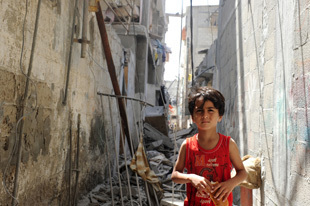 Photo: UN Photo/Shareef Sarhan
Photo: UN Photo/Shareef Sarhan
During the intense days of "Operation Protective Edge," in an atmosphere of intimidation within Israel, thousands of Israelis nonetheless flooded the main squares of cities protesting the occupation of Palestinian territories and the massacres in Gaza. Prospects for ending the conflict and securing justice may seem more distant than ever, but Palestinian solidarity activism, Israeli voices declaring "Not in My Name," and Pope Francis's call for reconciliation offer pathways toward peace.
New posts in the September 2014 issue of Peace Policy:
Asher Kaufman explains how Israel’s tactics against Hamas have eroded Israel's own political and moral strength. More »
Atalia Omer describes Israeli voices of dissent, their arguments, and how they fit within Palestine solidarity activism and regional peacebuilding efforts. More »
Patrick Gaffney explains Pope Francis’s emphasis on freeing Palestinians from oppression and Israelis from fear as the formula for integrating justice and security. More »
About Peace Policy
Peace Policy offers research-based insights, commentary, and solutions to the global challenge of violent conflict. Each issue features the writing of scholars and practitioners who investigate the causes of violent conflict and who seek to contribute to effective solutions and alternatives to the use of force.
Peace Policy is edited by David Cortright, director of policy studies at the Kroc Institute, dcortrig@nd.edu.
Visit the latest issue of Peace Policy at peacepolicy.nd.edu